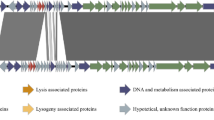Abstract
The 51 kilodalton (kDa) and the 42 kDa larvicidal proteins ofBacillus sphaericus 2362 appear to reside on a single transcriptional unit. Constructs containing the genes for both of these proteins or for only the 51 kDa or the 42 kDa protein were inserted into the appropriate expression vectors and the proteins over-produced inEscherichia coli JM105, andBacillus sphaericus strain 718 and SSII-1. In all of these organisms the 51 kDa and 42 kDa proteins were not toxic alone but were toxic in combination. These results are interpreted to indicate that theBacillus sphaericus 2362 larvicide is a binary toxin in that both the 51 and the 42 kDa proteins are required for toxicity.
Similar content being viewed by others
Literature Cited
Alexander B, Priest FG (1990) Numerical classification and identification ofBacillus sphaericus including some strains pathogenic for mosquito larvae. J Gen Microbiol 136:367–376
Amann E, Brosius J, Ptashne M (1983) Vectors bearing a hybrid trp-lac promoter useful for regulating expression of cloned genes inEscherichia coli. Gene 25:167–178
Arapinis C, de la Torre F, Szulmajster J (1988) Nucleotide and deduced amino acid sequence of theBacillus sphaericus 1593M gene encoding a 51.4 kDa polypeptide which acts synergistically with the 42 kDa protein for expression of the larvicidal toxin. Nucleic Acids Res 16:7731
Baumann L, Baumann P (1989) Expression inBacillus subtilis of the 51- and 42-kilodalton mosquitocidal toxin genes ofBacillus sphaericus Appl Environ Microbiol 55:252–253
Baumann L, Broadwell AH, Baumann P (1988) Sequence analysis of the mosquitocidal toxin genes encoding 51.4- and 41.9-kilodalton proteins fromBacillus sphaericus 2362 and 2297. J. Bacteriol 170:2045–2050
Baumann P, Unterman BM, Baumann L, Broadwell AH, Abbene SJ, Bowditch RD (1985) Purification of the larvicidal toxin ofBacillus sphaericus and evidence for high-molecular-weight precursors. J Bacteriol 163:738–747
Baumann P, Baumann L, Bowditch RD, Broadwell AH (1987) Cloning of the gene for the larvicidal toxin ofBacillus sphaericus 2362: evidence for a family of related sequences. J Bacteriol 169:4061–4067
Broadwell AH, Baumann P (1986) Sporulation-associated activation ofBacillus sphaericus larvicide. Appl Environ Microbiol 52:758–764
Broadwell AH, Baumann L, Baumann P (1990) The 42- and 51-kilodalton mosquitocidal proteins ofBacillus sphaericus 2362: construction of recombinants with enhanced expression andin vivo studies of processing and toxicity. J Bacteriol 172:2217–2223
Broadwell AH, Clark MA, Baumann L, Baumann P (1990) Construction by site-directed mutagenesis of a 39-kilodalton mosquitocidal protein similar to the larvae-processed toxin ofBacillus sphaericus 2362. J. Bacteriol 172:4032–4036
Charles J-F (1987) Ultrastructural midgut events in Culicidae larvae fed withBacillus sphaericus 2297 spore/crystal complex. Ann Inst Pasteur (Paris) 138:471–484
Davidson EW (1986) Effects ofBacillus sphaericus 1593 and 2362 spore/crystal toxin on cultured mosquito cells. J Invertbr Pathol 47:21–31
De la Torre F, Bennardo T, Sebo P, Szulmajster J (1989) On the respective roles of the two proteins encoded by theBacillus sphaericus 1593M toxin genes expressed inEscherichia coli andBacillus subtilis. Biochem Biophys Res Commun 164:1417–1422
Hindley J, Berry C (1987) Identification, cloning and sequence analysis of theBacillus sphaericus 1593 41.9 kD larvicidal toxin gene. Mol Microbiol 1:187–194
Höfte H, Whiteley HR (1989) Insecticidal crystal proteins ofBacillus thuringiensis. Microbiol Rev 53:242–255
Krych VK, Johnson JL, Yousten AA (1980) Deoxyribonucleic acid homologies among strains ofBacillus sphaericus. Int J Syst Bacteriol 30:476–484
Maniatis T, Fritsch EF, Sambrook J (1982) Molecular cloning: a laboratory manual. Cold Spring Harbor, New York: Cold Spring Harbor Laboratory
Park S-S Wong S-L, Wang L-F, Doi RD (1989)Bacillus subtilis subtilisin gene (aprE) is expressed from a σA (σ43) promoterin vitro andin vivo. J Bacteriol 171:2657–2665
Sgarrella F, Szulmajster J (1987) Purification and characterization of the larvicidal toxin ofBacillus sphaericus 1593M. Biochem Biophys Res Commun 143:901–907
Simpson LL (1989) The binary toxin produced byClostridium botulinum enters cells by receptor-mediated endocytosis to exert its pharmacological effects. J Pharmacol Exp Ther 251:1223–1228
Simpson LL, Stiles BG, Zepeda HH, Wilkins, TD (1987) Molecular basis for the pathological actions ofClostridium perfringins iota toxin. Infect Immun 55:118–122
Singh Y, Leppla SH, Bhatnager R, Friedlander AM (1989) Internalization and processing ofBacillus anthracis lethal toxin by toxin-sensitive and -resistant cells. J Biol Chem 264:11099–11102
Yousten AA (1984)Bacillus sphaericus: microbiological factors related to its potential as a mosquito larvicide. Adv Biotechnol Processes 3:315–343
Author information
Authors and Affiliations
Rights and permissions
About this article
Cite this article
Broadwell, A.H., Baumann, L. & Baumann, P. Larvicidal properties of the 42 and 51 kilodaltonBacillus sphaericus proteins expressed in different bacterial hosts: Evidence for a binary toxin. Current Microbiology 21, 361–366 (1990). https://doi.org/10.1007/BF02199438
Issue Date:
DOI: https://doi.org/10.1007/BF02199438




